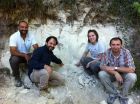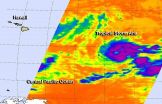Can big data make sense of climate change?
2014-10-14
(Press-News.org) New Rochelle, October 14, 2014 –Big Data analytics are helping to provide answers to many complex problems in science and society, but they have not contributed to a better understanding climate science, despite an abundance of climate data. When it comes to analyzing the climate system, Big Data methods alone are not enough and sound scientific theory must guide data modeling techniques and results interpretation, according to an insightful article in Big Data, the highly innovative, peer-reviewed journal from Mary Ann Liebert, Inc., publishers. The article is available free on the Big Data website.
In "A Big Data Guide to Understanding Climate Change: The Case for Theory-Guided Data Science," James Faghmous, PhD and Vipin Kumar, PhD, The University of Minnesota--Twin Cities, explore the challenges and opportunities for mining large climate datasets and the subtle differences that are needed compared to traditional Big Data methods if accurate conclusions are to be drawn. The authors discuss the importance of combining scientific theory and First Principles with Big Data analytics and use examples from existing research to illustrate their novel approach.
"This paper is a great example of leveraging the abundance of climate data with powerful analytical methods, scientific theory, and solid data engineering to explain and predict important climate change phenomena," says Big Data Editor-in-Chief Vasant Dhar, Co-Director, Center for Business Analytics, Stern School of Business, New York University.
INFORMATION:
About the Journal
Big Data , published quarterly in print and online, facilitates and supports the efforts of researchers, analysts, statisticians, business leaders, and policymakers to improve operations, profitability, and communications within their organizations. Spanning a broad array of disciplines focusing on novel big data technologies, policies, and innovations, the Journal brings together the community to address the challenges and discover new breakthroughs and trends living within this information. Complete tables of content and a sample issue may be viewed on the Big Data website.
About the Publisher
Mary Ann Liebert, Inc., publishers is a privately held, fully integrated media company known for establishing authoritative medical and biomedical peer-reviewed journals, including OMICS: A Journal of Integrative Biology, Journal of Computational Biology, New Space, and 3D Printing and Additive Manufacturing. Its biotechnology trade magazine, Genetic Engineering & Biotechnology News (GEN), was the first in its field and is today the industry's most widely read publication worldwide. A complete list of the firm's more than 80 journals, newsmagazines, and books is available on the Mary Ann Liebert, Inc., publishers website.
[Attachments] See images for this press release:

ELSE PRESS RELEASES FROM THIS DATE:
2014-10-14
ATHENS, Ohio (Oct. 14, 2014)—It's been millions of years since T. rex took its last breath, but a team led by Ohio University scientists is breathing life back into dinosaurs using high-powered computer simulations to model airflow through dinosaur snouts. The research has important implications for how dinosaurs used their noses to not only breathe but to enhance the sense of smell and cool their brains.
"Dinosaurs were pretty 'nosy' animals," said Ohio University doctoral student Jason Bourke, lead author of the new study published today in the Anatomical Record. ...
2014-10-14
In 2012, the "Mars One" project, led by a Dutch nonprofit, announced plans to establish the first human colony on the Red Planet by 2025. The mission would initially send four astronauts on a one-way trip to Mars, where they would spend the rest of their lives building the first permanent human settlement.
It's a bold vision — particularly since Mars One claims that the entire mission can be built upon technologies that already exist. As its website states, establishing humans on Mars would be "the next giant leap for mankind."
But engineers at MIT say the project ...
2014-10-14
This week, an international team of researchers, led by the Chinese Academy of Agricultural Sciences in Beijing, published in the journal Nature Genetics a brief genomic history of tomato breeding, based on sequencing of 360 varieties of the tomato plant.
The C.M. Rick Tomato Genetics Resource Center at UC Davis played an important role in this study by providing seed of both cultivated tomato varieties and related wild species.
This study, which builds on the first tomato genome sequence completed just two years ago, shows in great detail how the processes of early ...
2014-10-14
Researchers at Ludwig-Maximilians-Universitaet (LMU) in Munich have chemically modified an anti-diabetic agent so as to make its action dependent on light. The resulting prototype compound, termed JB253, induces release of insulin only when pancreas cells are exposed to blue light.
Synthetic, light-sensitive, molecular switches can be utilized to control biochemical signaling processes in living cells. In a new study, a research team led by LMU Professor Dirk Trauner (Chemical Biology and Genetics) and his colleague Johannes Broichhagen, in collaboration with Prof. Guy ...
2014-10-14
Imagine the world waking up one morning to discover that all compasses pointed south instead of north.
It's not as bizarre as it sounds. Earth's magnetic field has flipped – though not overnight – many times throughout the planet's history. Its dipole magnetic field, like that of a bar magnet, remains about the same intensity for thousands to millions of years, but for incompletely known reasons it occasionally weakens and, presumably over a few thousand years, reverses direction.
Now, a new study by a team of scientists from Italy, France, Columbia University ...
2014-10-14
ITHACA, N.Y. – Scientists have sequenced the house fly genome for the first time, revealing robust immune genes, as one might expect from an insect that thrives in pathogen-rich dung piles and garbage heaps.
The research, published Oct. 14 in the journal Genome Biology, will increase understanding of house fly genetics and biology and of how flies quickly adapt to resist insecticides, which could lead to novel control methods.
Adult house flies (Musca domestica) carry and transmit more than 100 human and animal diseases, including salmonellosis, anthrax, typhoid ...
2014-10-14
NASA's Aqua satellite passed over Tropical Storm Ana on Monday, Oct. 13 after it formed in the Central Pacific Ocean.
Ana formed on Oct. 13 at 5 p.m. EDT (11 a.m. HST) as Tropical Depression 2-C, about 920 miles (1,480 km) east-southeast of Hilo, Hawaii. By 9 p.m. EDT that day, the depression had strengthened into Tropical Depression Ana.
NASA's Aqua satellite passed over Tropical Storm Ana on Monday, Oct. 13 at 11:11 UTC (7:11 a.m. EDT) and the Atmospheric Infrared Sounder or AIRS instrument gathered infrared data that showed some strong thunderstorms and cold cloud ...
2014-10-14
WASHINGTON, DC— The 1934 drought was by far the most intense and far-reaching drought of the last 1,000 years in North America, and was caused in part by an atmospheric phenomenon that may have also led to the current drought in California, according to a new study.
New research finds that the extent of the 1934 drought was approximately seven times larger than droughts of comparable intensity that struck North America between 1000 A.D. and 2005, and nearly 30 percent worse than the next most severe drought that struck the continent in 1580.
"We noticed that ...
2014-10-14
One of the planet's leading questions is how to produce enough food to feed the world in an increasingly variable climate. The Food and Agriculture Organization of the United Nations predicts that food production must rise 70% over the next 40 years to feed a growing global population, and plants are one major component of the necessary rise in food production. Plants—grains, cereals, fruits, vegetables, and more—feed humans directly and indirectly by supporting livestock. Current research must tap into our knowledge of how plants work to develop more efficient ...
2014-10-14
From AGU's blogs: Health check reveals how glacier is declining due to warming climate http://blogs.agu.org/geospace/2014/10/13/health-check-reveals-glacier-declining-due-warming-climate/
Researchers from the British Geological Survey have taken the very first comprehensive health check of a rapidly melting glacier. Their latest study reveals that their icy patient, the Falljökull glacier in southeast Iceland, has been dramatically declining as it tries to adjust to recent changes in the climate.
The new findings on Falljökull show unhealthy changes in the ...
LAST 30 PRESS RELEASES:
[Press-News.org] Can big data make sense of climate change?




